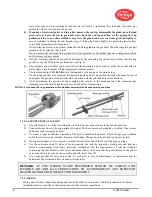
2
© 2020 Carrier
2. OPERATION PRINCIPLE AND TECHNICAL SPECIFICATION
Unit construction provides a stable flame, with ignition repeatability. No moving parts ensures long, trouble-free
operation with low maintenance costs.
SureFire II
TM
Pilot SP-48-NG/PG-ND
can operate as an intermittent (light-off), or as a continuous gas pilot.
Main parts of
SP-48-ND
pilot are: air tube (pos. 4 on Fig. 1) with combustion-cooling air inlets covered by sliding
adjusting sleeve (pos. 5) secured by locking thumb screw and gas part assembly including gas head (pos. 3) with gas
inlet (1/2” BSP), ignition rod hole (1/2”BSP) with rod holding gland (pos. 7) and sight port hole (1/2” BSP) with stop
plug mounted. It includes also the fixed gas tube (pos. 2) with the orifice-stabilizer assembly (pos. 1) consisting of a
gas divider with main and bleed orifices, gas tube and stabilizer. Gas part assembly is mounted in the air tube by
means of the thread joint with mounting ring (pos. 6).
Note that gas supply line should be equipped with an effective strainer unit to prevent the orifices from clogging.
In many applications
SP-48
pilots are mounted on the main burner in the mounting tube (see p. 3).
The source of ignition is an electrical high energy spark igniter (HESI) or high tension arc igniter (HTI) for safe or
hazardous area (depends on the application) equipped with the ignition rods of outer diameter up to 16 mm and co-
axial electrode arrangement – see Fig. 3.
The ignition rod is mounted in the gas head and passes through the air tube to the mounting bracket of stabilizer
assembly. The rod tip end should be placed as on drawing Fig. 1 (depending on the kind of ignition device), to
provide a successful ignition of air-gas mixture.
Gas pilot
SP-48-NG/PG-ND
can be supplied together with electrical ignition device selected depending on the
application. Ignition device is not in gas igniter scope, it is specified separately and should be separately ordered.
SP-48-NG/PG-ND
gas pilot principle of use: gas is supplied through the inlet 1/2" BSP to the gas head and to the gas
tube and further to the orifice-stabilizer assembly. A small amount of gas leaves through the bleed orifice mounted in
the gas divider, into the zone before the stabilizer plate, where it mixes with air to form a combustible mixture. It is
ignited in that zone by a spark or an electric arc generated at the tip of the electrical igniter rod. This pilot flame
stabilizes at stabilizer plate with holes. Further it ignites the main stream of gas which exits the main nozzle at outlets
of gas and air tubes. The main flame then stabilizes in the primary combustion zone at the outlet of the air tube. The
stabilizer plate and holes in air tube provide an adequate shape and stability of the flame.
The orifice-stabilizer assembly is optimized for Natural gas or Propane gas/LPG. In case of other Fuel gas type or
other capacity needed, contact Fireye as this may need the pilot construction changes - see p. 11 for Special Pilots.
Thanks to this principle of design, the pilot combustion zone is protected, the main combustion zone is outside the
igniter, hence the air tube does not overheat there is no need for retraction of the ignition rod.
Pilot has to be mounted on main burner such that no part of pilot shall be in the main burner flame and cannot project
beyond the heater lining or a burner throat. The distance of the tip of pilot air tube from the main burner flame should
not be smaller than 150 mm – see Appendix 2.
The flame length is 0.4 – 0.6 m depending on the kind of gas, gas pressure versus the pressure in combustion
chamber and environmental conditions outside boiler/heater.
In addition, using Fireye high tension igniter type
HTSS
in the
Spark & Sense
version, the center electrode of
igniter rod is also an ionization rod extended into the primary combustion zone and specially designed to work with
SureFire II
TM
Pilots
.
The HT igniter initially creates the electric arc to ignite the gas, and then the circuit switches the operating mode for
ionization detection, confirming the presence of the igniter flame.
FIGURE 2.
Pilot mounting tubes: for welding and flanged


































